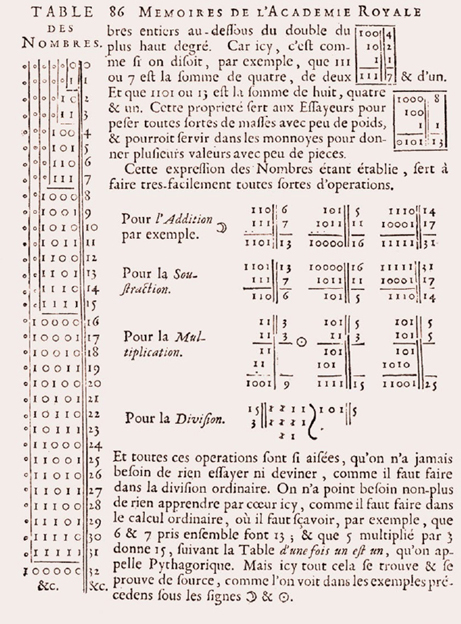1703
Binary Arithmetic
Gottfried Wilhelm Leibniz (1646–1716)
All information inside a computer is represented as a series of binary digits—0s and 1s—better known as bits. To represent larger numbers—or characters—requires combining multiple binary digits together into binary numbers, also called binary words.
We write decimal numbers with the least significant digit on the right-hand side; each successive digit to the left represents 10 times as much as the previous digit, so the number 123 can be explained as:
123 = 1 × 100 + 2 × 10 + 3 × 1
Which is also equal to:
123 = 1 × 102 + 2 × 101 + 3 × 100
Binary numbers work the same way, except that the multiplier is 2, rather than 10. So the number one hundred and twenty three would be written:
1111011 = 1 × 26 + 1 × 25 + 1 × 24 + 1 × 23 + 0 × 22 + 1 × 21 +1 × 20
Although forms of binary number systems can be traced back to ancient China, Egypt, and India, it was German mathematician Gottfried Wilhelm Leibniz who worked out the rules for binary addition, subtraction, multiplication, and division and then published them in his essay, “Explication de l’arithmétique binaire, qui se sert des seuls caractères 0 & 1; avec des remarques sur son utilité, et sur ce qu’elle donne le sens des anciennes figuers chinoises de Fohy” (“Explanation of binary arithmetic, which uses only characters 0 & 1; with remarks about its utility and the meaning it gives to the ancient Chinese figures of Fuxi”).
One of the advantages of binary arithmetic, he wrote, is that there is no need to memorize multiplication tables or to perform trial multiplications to compute divisions: all one needs to do is apply a small set of straightforward rules.
All modern computers use binary notation and perform arithmetic using the same laws that Leibniz first devised.
SEE ALSO Floating-Point Numbers (1914), Binary-Coded Decimal (1944), The Bit (1948)
A table from Gottfried Wilhelm Leibniz’s essay “Explanation of Binary Arithmetic,” published in the Mémoires de l’Académie Royale des Sciences in 1703, shows the rules for adding, subtracting, multiplying, and dividing binary numbers.
